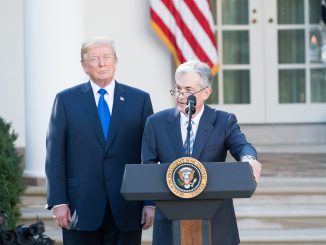I have made the case many times that the Fed is a monetary superpower. It controls the world’s main reserve currency and many emerging markets are formally or informally pegged to dollar. Consequently, its monetary policy gets exported across much of the globe. The other two monetary powers, the ECB and the Bank of Japan, are therefore mindful of U.S. monetary policy lest their currencies becomes too expensive relative to the dollar and all the other currencies pegged to the dollar. As as result, the Fed’s monetary policy gets exported to some degree to Japan and the Euro area as well. This understanding implies the Fed helped fuel excessive global liquidity in the early-to-mid 2000s, but now it is doing the opposite with its passive tightening of monetary policy.
This understanding also weaves nicely into the shortage of safe assets story. Back in the early-to-mid 2000s the Fed’s loose monetary policy meant dollar-peggers had to buy up more dollars to maintain their pegs. These economies then used the dollars to buy up U.S. debt. This increased the demand for safe assets and further drove down yields. Fast forward to late 2008. The Fed fails to prevent the collapse of NGDP and never attempts to fully restore it to some reasonable pre-crisis path. This causes the destruction of many safe assets and thus further exacerbates the safe-asset problem. Now these developments are only the cyclical part of the safe asset problem–there was also a structural shift in demand for safe assets coming the emerging world–but it is an important part of the story.
I bring this up because Andrea Ferrero of the New York Fed has a new paper that makes a similar argument. He, however, uses more formal modeling than me and notes the implications for the current account deficits. He is careful not to say the Fed’s monetary superpower status was the only factor, yet finds that it was quantitatively important. Here is an Ferrero:
[T]hese [pegging] countries import U.S. monetary policy so that low U.S. interest rates lead to low global interest rates. The quantitative analysis shows that foreign pegs, coupled with over-expansionary U.S. monetary policy, exert additional downward pressure on the real interest rate and impair a real depreciation of the dollar that would help rebalance the U.S. current account de cit. Taken together, the relaxation of borrowing constraints and low interest rates in the U.S. coupled with foreign pegs account for about two-thirds of the increase in real house prices and almost one-half of the deterioration of the current account during the rst half of the 2000s. These quantitative ndings complement the role of other factors in accounting for the correlation between the house price boom and the deterioration of the current account in the U.S. during the early 2000s.
As noted above, the flip side of this argument is that Fed being too tight for the global economy, at least passively.
- Bulenox: Get 45% to 91% OFF ... Use Discount Code: UNO
- Risk Our Money Not Yours | Get 50% to 90% OFF ... Use Discount Code: MMBVBKSM
Disclaimer: This page contains affiliate links. If you choose to make a purchase after clicking a link, we may receive a commission at no additional cost to you. Thank you for your support!




Leave a Reply